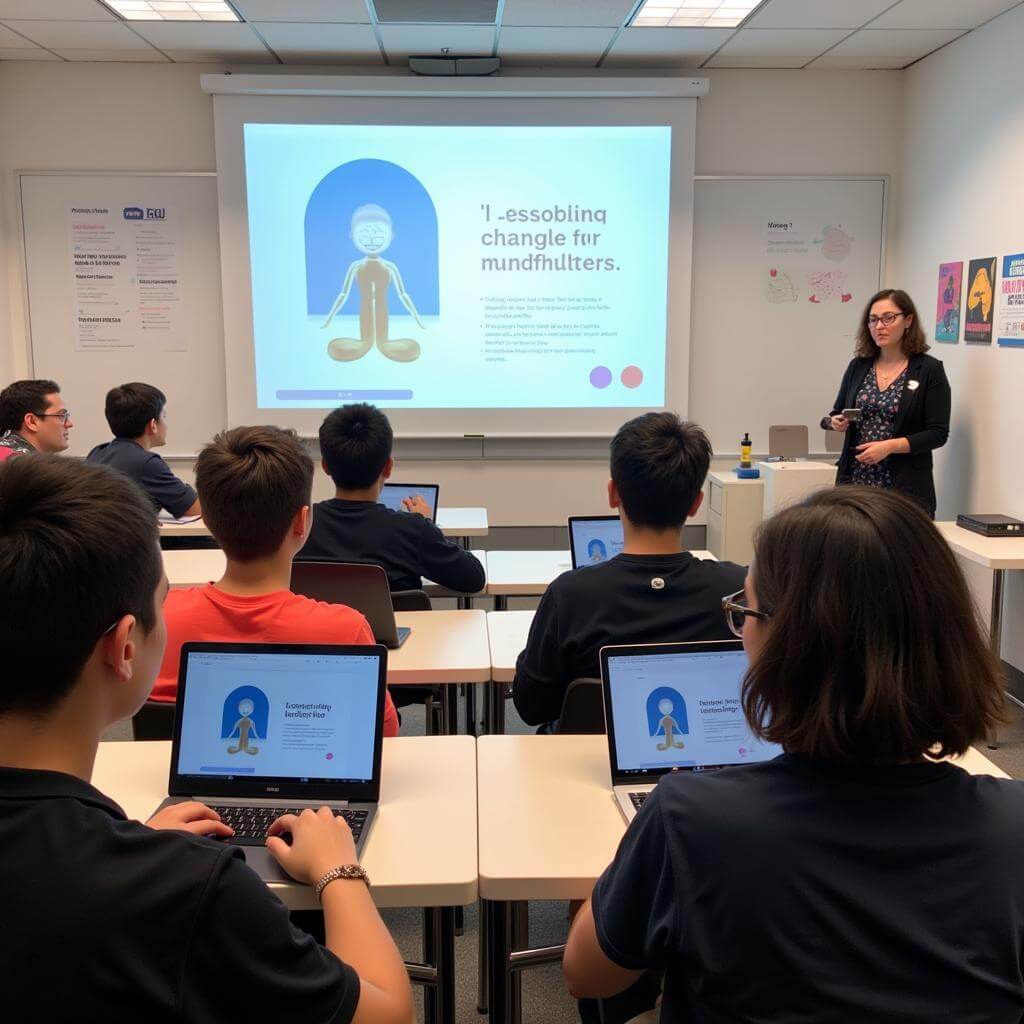The IELTS Reading test can be challenging, especially when tackling unfamiliar topics. Today, we’ll explore a practice test focused on mindfulness apps for student well-being, a subject that has gained significant attention in recent years. How to promote mental health for students is an increasingly important topic, and this practice test will help you improve your reading skills while learning about this valuable subject.
Nội dung bài viết
- IELTS Reading Practice Test
- Passage 1 – Easy Text
- The Rise of Mindfulness Apps in Education
- Questions 1-5
- Questions 6-10
- Passage 2 – Medium Text
- The Impact of Mindfulness Apps on Student Mental Health
- Questions 11-14
- Questions 15-19
- Passage 3 – Hard Text
- The Neuroscience Behind Mindfulness Apps and Student Cognitive Enhancement
- Questions 20-23
- Questions 24-26
- Questions 27-30
- Answer Key
- Passage 1
- Passage 2
- Passage 3
IELTS Reading Practice Test
Passage 1 – Easy Text
The Rise of Mindfulness Apps in Education
In recent years, there has been a remarkable surge in the use of mindfulness apps among students. These digital tools are designed to help young people manage stress, improve focus, and enhance overall well-being. As academic pressures continue to mount, educational institutions are increasingly recognizing the importance of supporting students’ mental health.
Mindfulness apps offer a range of features, from guided meditations to breathing exercises and sleep stories. Many of these applications are specifically tailored for students, addressing common issues such as exam anxiety, time management, and social pressures. The accessibility and discretion of smartphone apps make them particularly appealing to young users who might be hesitant to seek traditional forms of support.
Research has shown that regular use of mindfulness apps can lead to reduced stress levels, improved emotional regulation, and better academic performance. Some schools have even begun incorporating these apps into their curriculum, recognizing their potential to create a more balanced and supportive learning environment.
However, it’s important to note that while these apps can be beneficial, they should not be seen as a replacement for professional mental health support when needed. Rather, they serve as a complementary tool in a broader approach to student well-being.
 Students using mindfulness apps on smartphones
Students using mindfulness apps on smartphones
Questions 1-5
Do the following statements agree with the information given in the reading passage?
Write:
TRUE if the statement agrees with the information
FALSE if the statement contradicts the information
NOT GIVEN if there is no information on this
- Mindfulness apps are exclusively used by university students.
- These apps offer features like guided meditations and breathing exercises.
- Some schools have integrated mindfulness apps into their teaching programs.
- All students who use mindfulness apps show improved academic performance.
- Mindfulness apps can completely replace professional mental health support.
Questions 6-10
Complete the sentences below.
Choose NO MORE THAN TWO WORDS from the passage for each answer.
- The use of mindfulness apps among students has seen a __ __ in recent years.
- These apps are designed to help students manage stress and improve their __.
- Many apps are tailored to address issues such as __ __ and time management.
- The __ of smartphone apps makes them attractive to young users.
- Regular use of these apps can lead to better __ __ in students.
Passage 2 – Medium Text
The Impact of Mindfulness Apps on Student Mental Health
The proliferation of mindfulness apps targeted at students has sparked a debate about their effectiveness in promoting mental well-being. While proponents argue that these digital tools offer accessible and engaging ways to practice mindfulness, critics question whether they can truly address the complex mental health challenges faced by today’s students.
One of the primary benefits of mindfulness apps is their ability to introduce students to the concept of mindfulness in a familiar, technology-driven format. Many of these apps employ gamification techniques, turning mindfulness exercises into challenges or quests that appeal to younger users. This approach can make the practice of mindfulness more engaging and less intimidating for those new to the concept.
However, the effectiveness of these apps largely depends on consistent use and proper implementation. A study conducted by the University of Oxford found that while short-term use of mindfulness apps showed promising results in reducing stress and improving mood, long-term benefits were only observed in users who maintained regular practice. This raises questions about the sustainability of app-based interventions, particularly among students who may struggle with time management or maintaining new habits.
Another concern is the potential for these apps to oversimplify complex mental health issues. While mindfulness can be a valuable tool for managing stress and anxiety, it is not a panacea for all mental health concerns. Critics argue that overreliance on apps might prevent students from seeking professional help when needed, potentially exacerbating underlying mental health conditions.
Despite these concerns, many educational institutions are incorporating mindfulness apps into their student support services. Some universities have partnered with app developers to create customized platforms that address specific challenges faced by their student populations. These collaborations aim to create more targeted and effective interventions that complement existing mental health resources on campus.
How to promote mental health in college students remains a critical concern, and mindfulness apps represent just one facet of a multifaceted approach to student well-being. As the technology continues to evolve, researchers and educators are working to develop best practices for integrating these tools into comprehensive mental health strategies for students.
 Students using mindfulness apps in a classroom setting
Students using mindfulness apps in a classroom setting
Questions 11-14
Choose the correct letter, A, B, C, or D.
-
What is one of the main advantages of mindfulness apps for students?
A) They are more effective than traditional therapy
B) They make mindfulness practice more engaging
C) They are only available to university students
D) They guarantee improved academic performance -
According to the University of Oxford study, what is necessary for long-term benefits from mindfulness apps?
A) Short-term use only
B) Combining app use with medication
C) Regular and consistent practice
D) Using multiple apps simultaneously -
What concern is raised about the simplification of mental health issues by apps?
A) Apps may be too complex for students to use
B) Students might avoid seeking professional help when needed
C) Apps are not effective in reducing stress
D) The technology used in apps is outdated -
How are some universities responding to the rise of mindfulness apps?
A) By banning their use on campus
B) By replacing all traditional counseling services with apps
C) By creating customized platforms with app developers
D) By discouraging students from using any mental health apps
Questions 15-19
Complete the summary below.
Choose NO MORE THAN TWO WORDS from the passage for each answer.
Mindfulness apps for students have become increasingly popular, offering a (15) __ approach to mental well-being. These apps often use (16) __ techniques to make mindfulness exercises more appealing. However, the (17) __ of these apps depends on regular use. While they can be helpful for managing stress, critics warn against (18) __ on apps for all mental health issues. Many educational institutions are now (19) __ mindfulness apps into their student support services.
Passage 3 – Hard Text
The Neuroscience Behind Mindfulness Apps and Student Cognitive Enhancement
The burgeoning field of educational neuroscience has begun to elucidate the neurological mechanisms underlying the effects of mindfulness practices on student cognition and well-being. As mindfulness apps proliferate in educational settings, researchers are investigating how these digital interventions interact with neural pathways associated with attention, emotional regulation, and learning.
Recent neuroimaging studies have demonstrated that regular mindfulness practice, even when facilitated through mobile applications, can lead to structural and functional changes in the brain. The prefrontal cortex, a region crucial for executive functions such as decision-making and impulse control, has been shown to exhibit increased gray matter density in individuals who engage in consistent mindfulness exercises. This neuroplastic change is particularly significant for students, as it suggests potential improvements in cognitive abilities that are fundamental to academic success.
Moreover, mindfulness practices have been associated with modulation of the default mode network (DMN), a set of interconnected brain regions active during self-referential thinking and mind-wandering. Regular mindfulness training appears to attenuate DMN activity, potentially reducing rumination and enhancing students’ ability to focus on present tasks. This neurological effect may explain the reported improvements in concentration and reduced test anxiety among students who use mindfulness apps.
The amygdala, the brain’s emotional processing center, also shows altered activity patterns in response to mindfulness training. Studies indicate a diminution in amygdala reactivity to stress stimuli following consistent mindfulness practice, suggesting enhanced emotional regulation capabilities. For students facing high-pressure academic environments, this neurological adaptation could prove invaluable in managing stress and maintaining emotional equilibrium.
However, the translation of these neuroscientific findings into effective app-based interventions presents significant challenges. The heterogeneity of student populations, with varying neural profiles and cognitive needs, necessitates a nuanced approach to app design. Some researchers advocate for the development of adaptive mindfulness apps that can tailor exercises based on real-time neurophysiological data, potentially optimizing the cognitive benefits for individual users.
Furthermore, the long-term neuroplastic effects of app-based mindfulness practices remain a subject of ongoing research. While short-term studies have shown promising results, the sustainability of these neural changes and their impact on academic performance over extended periods require further investigation. Mental health apps for teens are increasingly being designed with these neuroscientific principles in mind, aiming to create more targeted and effective interventions.
As the field of educational neuroscience continues to evolve, it is likely that mindfulness apps will become more sophisticated in their ability to promote specific cognitive enhancements. The integration of neurofeedback mechanisms and personalized algorithms may lead to the development of highly effective tools for supporting student mental health and cognitive function. However, ethical considerations regarding data privacy and the potential for cognitive enhancement must be carefully addressed as these technologies advance.
Questions 20-23
Choose the correct letter, A, B, C, or D.
-
According to the passage, what change has been observed in the prefrontal cortex of individuals who practice mindfulness regularly?
A) Decreased gray matter density
B) Increased gray matter density
C) No change in structure
D) Reduced activity during decision-making -
How does mindfulness training affect the default mode network (DMN)?
A) It increases DMN activity
B) It has no effect on the DMN
C) It reduces DMN activity
D) It eliminates the DMN completely -
What change in the amygdala is associated with consistent mindfulness practice?
A) Increased reactivity to stress stimuli
B) No change in activity patterns
C) Decreased reactivity to stress stimuli
D) Complete deactivation of the amygdala -
What challenge is mentioned regarding the development of effective mindfulness apps?
A) The cost of neuroimaging technology
B) The heterogeneity of student populations
C) The lack of interest from students
D) The inability to measure brain activity
Questions 24-26
Complete the sentences below.
Choose NO MORE THAN TWO WORDS from the passage for each answer.
- Some researchers suggest developing adaptive mindfulness apps that can customize exercises based on __ __ data.
- The __ of neural changes resulting from app-based mindfulness practices over long periods is still being researched.
- Future mindfulness apps may incorporate __ mechanisms to create more effective tools for supporting student mental health.
Questions 27-30
Do the following statements agree with the claims of the writer in the reading passage?
Write:
YES if the statement agrees with the claims of the writer
NO if the statement contradicts the claims of the writer
NOT GIVEN if it is impossible to say what the writer thinks about this
- All students who use mindfulness apps will experience significant improvements in academic performance.
- The integration of neurofeedback in mindfulness apps raises ethical concerns about data privacy.
- Mindfulness apps are more effective than traditional meditation practices for students.
- Future research in educational neuroscience will likely lead to more sophisticated mindfulness apps for students.
Answer Key
Passage 1
- NOT GIVEN
- TRUE
- TRUE
- NOT GIVEN
- FALSE
- remarkable surge
- focus
- exam anxiety
- accessibility
- emotional regulation
Passage 2
- B
- C
- B
- C
- technology-driven
- gamification
- effectiveness
- overreliance
- incorporating
Passage 3
- B
- C
- C
- B
- neurophysiological
- sustainability
- neurofeedback
- NO
- YES
- NOT GIVEN
- YES
This comprehensive IELTS Reading practice test on mindfulness apps for student well-being covers a range of topics from the basic introduction to these apps to their neurological impacts. By engaging with this material, you’re not only preparing for your IELTS exam but also gaining valuable insights into an important aspect of student life. Remember, consistent practice is key to improving your reading skills and achieving your desired IELTS score. Best mindfulness apps for anxiety can be a great resource for further exploration of this topic.


